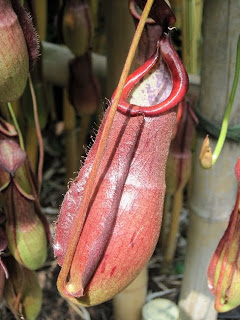Last week I shared photos from the "Blooming Butterflies" exhibit at Olbrich Botanical Gardens, which is held every summer in the Bolz Conservatory. As promised, here are a few pics of some of the plant life you'll find inside.
The Bolz Conservatory opened in November 1991 and has seen more than 1.5 million visitors since then. Many of the tropical and sub-tropical plants grown and conserved here are endangered in the wild. There are more than 650 different plants, as well as birds, geckos and tree toads that help control insect infestations.
The glass pyramid measures 100 by 100 feet, and is 50 feet tall at its center. The temperature is kept at a constant 65 to 80 degrees, but may warm up to 95F on hot summer days. It is kept above 60 percent humidity year-round, so is especially nice to visit during those cold, dry winter months.

Pitcher Plant These are one of my favorite plants in the Bolz Conservatory. While they may be cute, they are also carniverous plants that eat insects. Also known as "Monkey Cups," they are native to India, South East Asia, Madagascar and Australia.

Oranges are one of many food plants that can be found here. You might also see cacao, coffee, banana, vanilla and papaya.

Hibiscus There are several hundred species of hibiscus, and they are found world-round in warm-temperate, tropical and subtropical regions.

Hanging Lobster Claw Another cool tropical plant. Native to Central and South America.

Moth Orchid There are several different species of orchids, including these pretty purple ones.

Fuschia There are around 110 different species, most of which are native to South America, but they are also found in Central and North America, and from New Zealand to Tahiti. While most are purple or magenta in color, they can also be orange or white (or any combination thereof).

Fishtail Palm Native to Southeast Asia and India, this tree can be grown in some southern states. It is "cold hardy" down to 15F and requires shade to partial shade. It requires a lot of water with good drainage.

Anthurium or Flamingo Lily Also called Boy Flower (for obvious reasons, snicker). There are some 600-800 species of these, and maybe even up to 1000. Primarily found in wet tropical mountain forest of Central America and South America.

Chenille Plant Also called Philippines Medusa, red hot cat's tail and fox tail. Originally native to Oceana, it can now be found in parts of the US and Mexico. While it can be grown as a houseplant, it is poisonous to animals if ingested. And yes, it is as fuzzy soft as it looks.

Calathea Also known as prayer plants, calatheas are native to the tropical Americas. In some areas the large leaves are used in handicrafts (such as containers) or to wrap fish for transport.

No idea what this one is--I couldn't find the placard naming it. It was probably hiding somewhere under all the foliage. I think it might be a type of orchid.

Phalaenopsis, or Bamboo Baby Orchid

Blushing Bromeliad Native to tropical South America.
Adelle Laudan * Xakara * Shelley Munro * Ron
Janet * Jennifer Leeland * Colleen * Maddy Barone
Paige Tyler * Darla M Sands * Alice Audrey





15 comments:
Beautiful! I might have to brave the heat and hit the conservatory here after being so inspired by all the loveliness! :)
Happy T13,
~Xakara
Out of the Shadows
Cool pics. I have a few of these in my garden.
Lobster claws, monkey cups, bromeliads, oh my. Lovely.
I thought the first one was a bug. We have an orchid like the one you posted growing in our compost. I thought it was dead but it came back to life.
The Pitcher Plant looks like a shoe for a 3 toed alien!!!
oooo those are so pretty! Very cool.
Love the flowers! But the humidity in those places. Yikes!
*hugs*
Paige
My TT is at http://paigetylertheauthor.blogspot.com/
Gorgeous. That fishtail one is very kewl. Thanks for sharing some great pics.
Happy T13!
Xakara: I bet even in the southern heat a trip to the conservatory would be reviving!
Shelley: Which ones? You must share what is growing in your garden.
Ron: Thank you!
Colleen: Well, the pitcher plant is alive, but definitely not a bug. Which orchid do you have?
Lovely! Thank you for sharing. Happy TT!
Janet: ROFL...they do sort of look like funny little shoes, don't they? *g*
Jennifer: Thank you!
Paige: Yes, the humidity in conservatorys can be a little uncomfortable at certain times of the year, but it really did feel more comfortable inside that day than it did out.
Adelle: Isn't it cool? I couldn't help noticing them each time I passed through that section of the conservatory.
I'm wishing I'd visited it when I was out there last summer.
How interesting. The first one looked like a clog.
Have a great Thursday!
http://harrietandfriends.com/2011/08/back-to-school/
I think the unnamed one looks more like some kind of violet than an orchid. Did they have violets?
Great shots. I enjoyed looking at these. I used to have a fascination with the boy flower. I wonder why. Ha!
Darla: Thank you, glad you liked!
Alice: Would the family have allowed it? LOL
Harriet: I love hearing everyone's interpretations of the pitcher plant.
Anita: I didn't see any violets, but that doesn't mean there weren't any. I thought the unnamed plant might be an orchid as I think it was back in the same corner as the others.
Post a Comment